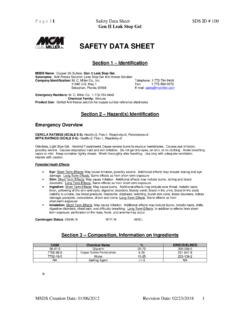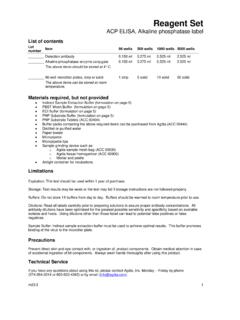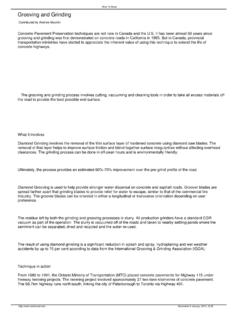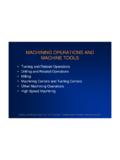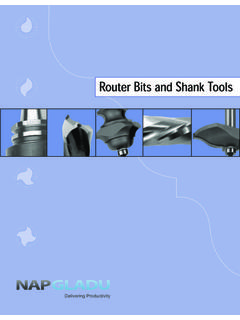Transcription of Submersible Reference Electrodes Revisited, …
1 30 MATERIALS PERFORMANCE October 2007 Submersible Reference Electrodes revisited ROBERT M. PARK, Miller Co., Inc., Vero Beach, FloridaTh is article examines the status of Submersible Reference Electrodes and presents a new design concept for Submersible copper/copper sulfate (Cu/CuSO4) Electrodes (CSE). In the new concept, the half-cell potential is independent of the salinity (chlorinity) of the electrolyte, the electrode is not subject to contamination, and structure-to-electrolyte voltages do not require correction to the CSE scale. Although copper/saturated copper sulfate (Cu/CuSO4) solution Reference Electrodes (CSEs) are the industry standard when it comes to measuring metallic structure-to-electrolyte voltages in the corrosion control fi eld, such Electrodes are deemed unsuitable for long-term immersion ser-vice (submersion applications).
2 1 This is because conventional CSEs have plugs (which make electrical contact with the electrolyte) that are porous. The porous nature of the plugs can lead to contami-nation of the CuSO4 by chloride ions (in seawater or brackish water applications, for example), particularly when the solu-tion in the electrode is not fully saturated, leading to changes in the half-cell poten-tial of the Contamination of the electrolyte by CuSO4 solution leakage from the electrode might also occur. As indicated in Reference 1, it is rec-ommended that dry silver/silver chlo-ride (Ag/AgCl)/seawater Reference Electrodes be used in submersion applica-tions, rather than CSEs, since such elec-trodes do not employ porous plugs. Ag/AgCl/seawater Reference Electrodes have disadvantages of their own, however. Silver/Silver Chloride ElectrodesFirst, Ag/AgCl/seawater Electrodes couple directly with the electrolyte (sea-water, brackish water, or fresh water, for example), since the electrolyte makes di-rect contact with the Ag/AgCl element when the electrode is immersed in the electrolyte.
3 Direct coupling means that the half-cell potential of the electrode is a function of the nature of the electrolyte, rather than being independent of the electrolyte. For example, in seawater or brackish water applications, at a given temperature, the half-cell potential of the electrode is dependent on the salinity (or, more specifi cally, the chloride ion activity) of the electrolyte. Consequently, a knowl-October 2007 30 October 2007 309/13/07 7:06:02 AM9/13/07 7:06:02 AMOctober 2007 MATERIALS PERFORMANCE 31 CATHODIC PROTECTION edge of the chlorinity of the electrolyte is required in order to interpret metallic structure-to-electrolyte voltages recorded using Ag/AgCl/seawater Reference elec-trodes. Peterson and Groover3 have estab-lished a relationship between the resistiv-ity of chloride ion-containing water and the chlorinity of the water (expressed as % seawater).
4 These authors also provide a means to correct metallic structure-to-electrolyte voltages recorded using a Ag/AgCl/seawater Reference electrode to the Cu/CuSO4 scale using a nomogram, based on the measured value of the elec-trolyte resistivity. Using the nomogram and having to measure the electrolyte resistivity are inconveniences relative to a direct reading using a CSE, for example. Second, again because of the direct coupling of the Ag/AgCl element to the electrolyte, coating of the element during the immersion process (by an oil fi lm, for example) renders the electrode inopera-ble. Third, Ag/AgCl/seawater Electrodes cannot be used in waters containing sul-fi de ions, since such exposure can perma-nently damage the Ag/AgCl element (silver sulfi de [Ag2S] is insoluble).Consequently, conventional CSEs and Ag/AgCl/seawater Reference Electrodes are not ideal for submersion applications.
5 The ideal scenario for a Submersible Reference electrode would be one in which the metallic structure-to-electrolyte readings would not require correction to the Cu/CuSO4 scale and solution trans-fer into, or out of, the electrode would not be possible. The solution to this problem is to use a plug on a CSE that is nonpo-rous (does not allow solution transfer), but is ionically Procedures and ResultsCSEs have been fabricated using a nonporous, ionically conducting plug material and metallic structure-to-elec-trolyte voltages have been recorded and FIGURE 1 TABLE 1 Native potential data from a mild steel test piece Electrolyte Resistivity ( cm)Potential with Respect to a Ag/AgCl/Seawater electrode (V)Potential with Respect to a CSE (V)20(Florida AtlanticCoast Seawater) (~7% seawater) ,000(<1% seawater) measured with respect to both an Ag/AgCl/seawater Reference electrode and a CSE in seawater and diluted seawater electrolytes using the arrangement shown in Figure 1.
6 The CSE had a nonporous, ionically conducting to those recorded using a Ag/AgCl/seawater Reference electrode . As indicated in Figure 1, the metallic struc-ture in the experiment was a piece of mild steel and the native potential of the steel plate was measured in various seawater and diluted seawater electro-lytes, with respect to both a Ag/AgCl/seawater electrode and a CSE having a nonporous, ionically conducting plug. The electrical resistance of the plug was measured to be ~10 k . All voltages were recorded at an electrolyte temperature of 22 C using a high input impedance volt-meter. The data recorded using both electrode types are illustrated in Table 1. Experimental arrangement to measure the native potential of steel plate material with respect to both a Ag/AgCl/seawater Reference electrode and a CSE in seawater and diluted seawater electrolytes (see Table 1).
7 The CSE had a nonporous, ionically conducting 2007 31 October 2007 319/13/07 7:06:10 AM9/13/07 7:06:10 AM32 MATERIALS PERFORMANCE October 2007 CATHODIC PROTECTIONS ubmersible Reference Electrodes RevisitedWith respect to the diagram shown in Figure 1, there are three contributions to the voltage as read by the voltmeter: V = [Metal Half-Cell Potential] [Ref. Electtrode Half-Cell Potential]+ IR (1)The Metal Half-Cell Potential term is typically a negative quantity (with re-spect to hydrogen) for anodic metals (like steel) and the Reference electrode Half-Cell Potential term is a positive quantity (with respect to hydrogen) for both CSEs and Ag/AgCl/sea water Electrodes . Con-sequently, the voltage data shown in Table 1 are negative IR term in Equation (1) repre-sents the voltage dropped in the electro-lyte itself.
8 For a fi xed geometry of ex-perimental setup ( , fi xed separation between the metal plate and Reference electrode and fi xed electrode [electrical] contact area), the primary variable con-tribution to the IR component is the re-sistivity of the electrolyte. If it assumed that the Metal Half-Cell Potential is essentially independent of the electrolyte resistivity, the measured voltage will be a function of both the Reference Elec-trode Half-Cell Potential and the IR components. As can be seen in Table 1, the voltage measured using the Ag/AgCl/seawater electrode shifts signifi -cantly in the negative direction as the electrolyte resistivity increases, while a smaller positive shift is indicated when using the CSE. These results can be ex-plained as follows:With respect to the CSE, the relatively small shift in the positive direction (23 mV for the electrolyte resistivity range examined) is due to an increase in the IR component with increasing electrolyte resistivity.
9 In this case, the Reference electrode Half-Cell Potential compo-nent is not a factor, since the half-cell potential of the CSE is independent of the electrolyte resistivity. On the other hand, when the Ag/AgCl/seawater electrode is used in the circuit, in addition to the same positive shift due to the IR change with increasing electrolyte resistivity (23 mV), a change in the Reference electrode Half-Cell Potential causes an overall negative shift in the voltage ( 110 mV). These data indicate that the Reference electrode Half-Cell Potential compo-nent, in the case of the Ag/AgCl/sea-water electrode , increases by 133 mV as the electrolyte resistivity is decreased over the range examined ( 133 mV + 23 mV = 110 mV). ConclusionsCSEs having a nonporous, ionically conducting plug are more suitable than Ag/AgCl/seawater Electrodes for sub-mersion applications, since their half-cell potential is independent of the salinity (chlorinity) of the electrolyte, they are not subject to contamination, and metallic structure-to-electrolyte voltages do not require correction to the Cu/CuSO4 scale.
10 It should be noted, however, that the IR component impacts the structure-to-electrolyte voltage reading for any elec-trode type. A native potential reading should be taken in the actual in-service electrolyte (for example, seawater, brack-ish water, fresh water, etc.) with a given Reference electrode and a given struc-ture/ electrode geometry to decide on the minimum structure-to-electrolyte voltage required for cathodic protection (as-read native potential plus 100 mV polariza-tion, for example).References1 NACE Standard RP0176-2003, Corrosion Control of Steel Fixed Offshore Structures Associated with Petroleum Production (Houston, TX: NACE International).2 Pawel, Lopez, E. Ondak, Chemical and Environmental Infl u-ences on Copper/Copper Sulfate Reference electrode Half-Cell Poten-tial, MP 37, 5 (1998): p.


